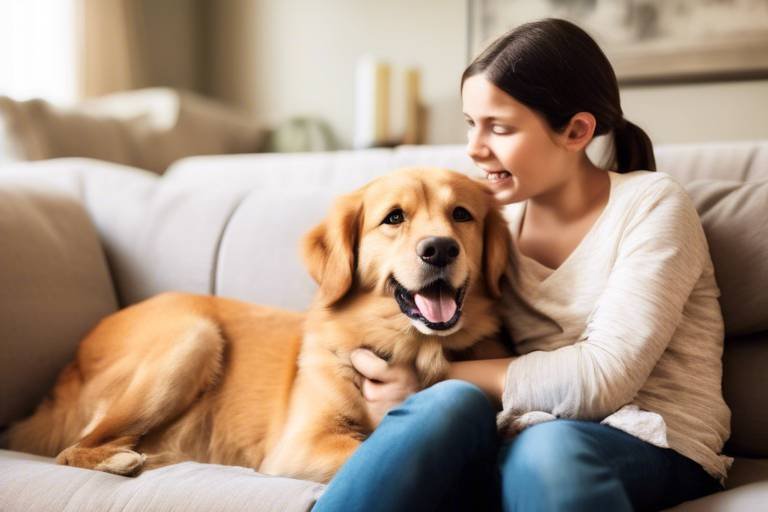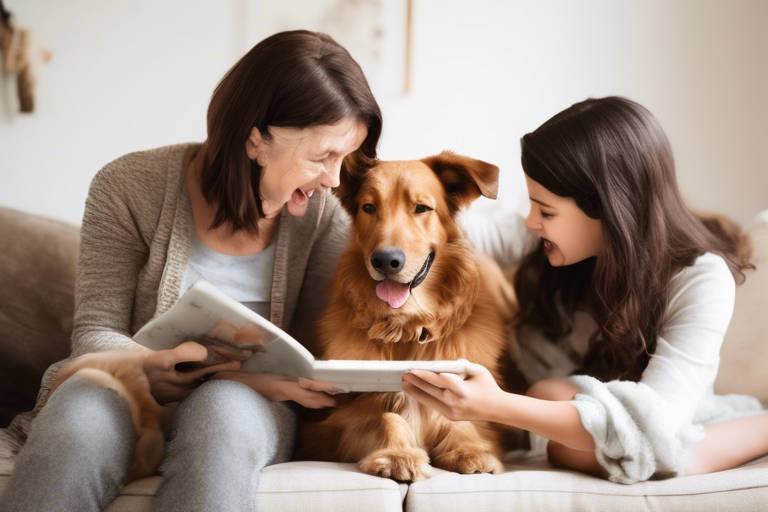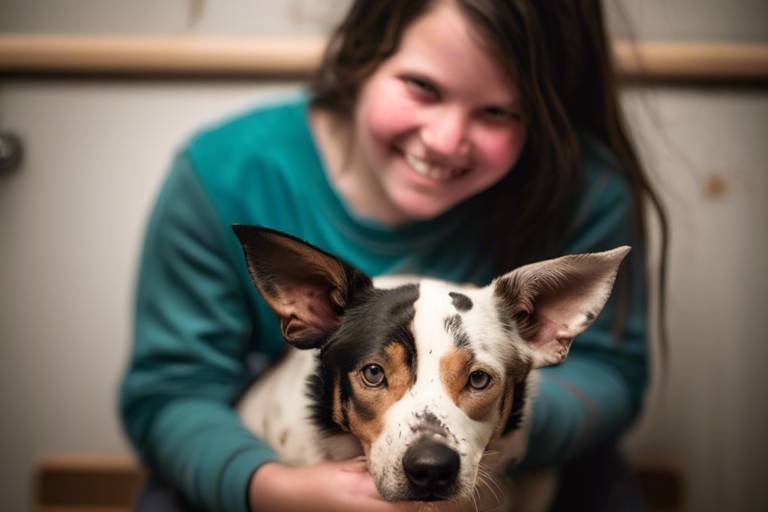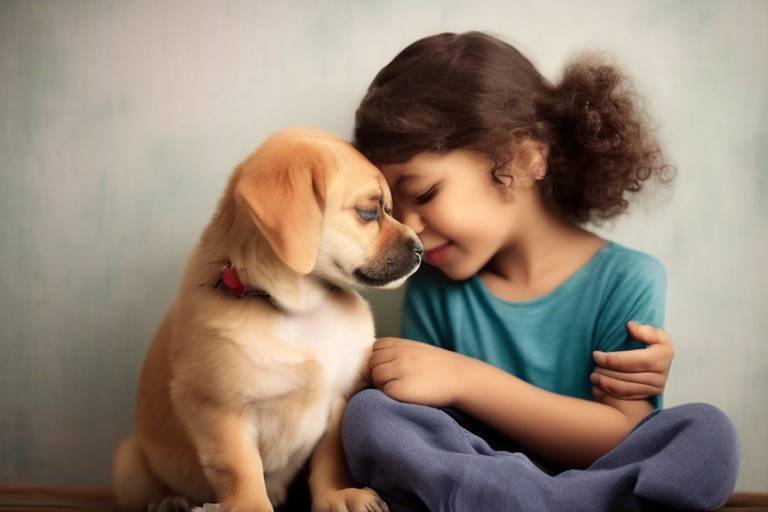Tips for a Smooth Transition for Your Adopted Pet
Adopting a pet is an incredibly rewarding experience, but it can also be a significant adjustment for both you and your new furry friend. Just like moving to a new house can be overwhelming for us, a new environment can be equally daunting for pets. The good news is that with some thoughtful planning and a little patience, you can create a smooth transition that fosters a happy and healthy relationship. In this article, we’ll explore essential strategies to help your adopted pet settle in comfortably, ensuring that both of you enjoy this exciting new chapter together.
Recognizing the history of your adopted pet is crucial. Every animal comes with a unique story, and understanding their previous experiences can help you tailor your approach to meet their specific needs. For instance, if your pet was previously in a shelter, they might have developed certain fears or anxieties that you need to address. Spending some time learning about their past can alleviate fears and help you create an environment that feels safe and welcoming. Remember, empathy goes a long way in helping your new companion adjust!
Establishing a secure and comfortable area for your new pet is essential. This space should be quiet and free from stressors, allowing your adopted pet to acclimate at their own pace. Think of it as their little sanctuary where they can retreat whenever they feel overwhelmed. You can enhance this safe space by including familiar items, such as blankets or toys from their previous home, which can provide a sense of security. The goal is to make them feel at home as quickly as possible.
Selecting an appropriate spot for your pet's safe space is vital. It should be away from high-traffic areas of your home to minimize disturbances. Consider a quiet corner of your living room or a cozy nook in your bedroom. This designated area can be their go-to spot for relaxation and comfort. Just like we all need our personal space, your pet will appreciate having a place where they can unwind and feel secure.
Providing necessary supplies like bedding, toys, and food ensures your pet feels at home. These items can significantly contribute to their comfort and help them settle in more quickly. Here’s a quick checklist of essentials:
- Bedding: A soft, comfortable bed can make all the difference.
- Toys: Engaging toys can help alleviate boredom and anxiety.
- Food and Water Bowls: Ensure they are easy to access and clean.
- Safe Treats: Use treats to create positive associations with their new environment.
When introducing your adopted pet to family members, take it slow. Gradual introductions can help prevent overwhelming your pet and foster positive relationships with everyone in the household. Think of it as introducing a new friend to your group; you wouldn’t want to throw them into the deep end right away! Start with short, supervised meetings and gradually increase the time spent together as your pet becomes more comfortable.
Creating a consistent daily routine can help your adopted pet feel more secure. Just like humans thrive on structure, pets also benefit from having a predictable schedule. Regular feeding, playtime, and walks will provide structure and predictability during their adjustment period. A routine not only helps your pet understand what to expect but also strengthens your bond as you engage in daily activities together.
Effective training and socialization are key components of a successful transition. These practices can help your pet adapt to their new environment and develop positive behaviors over time. Remember, patience is vital! Training is not just about commands; it's about building trust and communication between you and your pet.
Utilizing positive reinforcement during training encourages desirable behaviors. Rewarding your pet with treats or praise can enhance their learning experience and strengthen your bond. Think of it as a high-five for good behavior! The more positive experiences they associate with training, the more eager they will be to learn. Just remember, consistency is key!
Introducing your adopted pet to other animals can be beneficial. Proper socialization helps them learn appropriate behaviors and can ease any fears they may have about interacting with other pets. Start with short, positive interactions and always monitor their behavior. Just like humans, pets need time to adjust to new friends!
Keeping a close eye on your new pet's health is essential during the transition. Regular vet check-ups and monitoring for signs of stress can ensure they remain happy and healthy. Remember, a healthy pet is a happy pet!
Understanding the signs that indicate your pet may be stressed is crucial. Early recognition allows you to address their needs and create a more comfortable environment. Signs can include:
- Hiding or seeking solitude
- Excessive barking or meowing
- Loss of appetite
- Destructive behavior
Setting up a veterinary care schedule is important for your pet's health. Regular check-ups and vaccinations will help keep them safe and provide peace of mind for you as an owner. Think of your vet as your pet's personal health coach, guiding you both towards a long and healthy life together.
Q: How long does it take for an adopted pet to adjust?
A: The adjustment period varies by pet, but it typically takes a few days to a few weeks for them to feel comfortable in their new environment.
Q: What should I do if my pet shows signs of stress?
A: If your pet shows signs of stress, ensure they have a quiet space to retreat to, maintain a consistent routine, and consult with your veterinarian if necessary.
Q: Is training necessary for adopted pets?
A: Yes, training is essential for helping adopted pets adjust and develop good behaviors. It also strengthens the bond between you and your pet.

Understanding Your Pet's Background
This article provides essential guidance for pet owners to ensure a seamless adjustment period for their newly adopted furry friends, promoting a happy and healthy environment for both pets and owners.
When you bring a new pet into your home, it's like opening a book filled with untold stories and experiences. Every animal has a unique background that shapes their personality and behavior. Understanding your adopted pet’s history is crucial for several reasons. First off, it helps you identify any fears or anxieties they may have. For instance, a dog that has been mistreated might flinch at sudden movements or loud noises. By being aware of their past, you can tailor your approach and create a nurturing environment that promotes trust and security.
Moreover, knowing your pet's background can guide you in addressing their specific needs. For example, if your cat was previously an outdoor pet, they might feel anxious in a confined space. In such cases, gradually introducing them to their new environment can make a significant difference. You might even consider providing a window perch or a safe outdoor enclosure to help them acclimate without feeling trapped.
To gather insights into your pet's history, consider the following:
- Ask the Shelter or Rescue: They often have valuable information about the pet’s previous living situation, health, and behavior.
- Observe Behavior: Pay attention to how your pet reacts to different stimuli. This can give you clues about their past experiences.
- Consult with a Veterinarian: A vet can provide insights into your pet's health history and any potential issues that could affect their behavior.
Understanding your pet's background is not just about knowing where they came from; it's about building a bridge of trust and empathy. As you learn more about their past, you’ll be better equipped to help them adjust to their new home. Remember, patience is key. Just like us, pets need time to process their experiences and feel safe in their new surroundings. So, take a deep breath, be observant, and let your new furry friend blossom in their new life with you.
Establishing a secure and comfortable area for your new pet is essential. This space should be quiet and free from stressors, allowing your adopted pet to acclimate at their own pace.
Selecting an appropriate spot for your pet's safe space is vital. It should be away from high-traffic areas of your home to minimize disturbances and provide a sense of security.
Providing necessary supplies like bedding, toys, and food ensures your pet feels at home. These items can significantly contribute to their comfort and help them settle in more quickly.
When introducing your adopted pet to family members, take it slow. Gradual introductions can help prevent overwhelming your pet and foster positive relationships with everyone in the household.
Creating a consistent daily routine can help your adopted pet feel more secure. Regular feeding, playtime, and walks will provide structure and predictability during their adjustment period.
Effective training and socialization are key components of a successful transition. These practices can help your pet adapt to their new environment and develop positive behaviors over time.
Utilizing positive reinforcement during training encourages desirable behaviors. Rewarding your pet with treats or praise can enhance their learning experience and strengthen your bond.
Introducing your adopted pet to other animals can be beneficial. Proper socialization helps them learn appropriate behaviors and can ease any fears they may have about interacting with other pets.
Keeping a close eye on your new pet's health is essential during the transition. Regular vet check-ups and monitoring for signs of stress can ensure they remain happy and healthy.
Understanding the signs that indicate your pet may be stressed is crucial. Early recognition allows you to address their needs and create a more comfortable environment.
Setting up a veterinary care schedule is important for your pet's health. Regular check-ups and vaccinations will help keep them safe and provide peace of mind for you as an owner.
Q: How long does it take for an adopted pet to adjust?
A: It varies by pet, but typically, it can take anywhere from a few days to several weeks. Patience is key!
Q: Should I allow my new pet to explore the whole house at once?
A: It’s best to introduce them to one room at a time to avoid overwhelming them.
Q: What should I do if my pet shows signs of aggression?
A: Consult a professional trainer or veterinarian immediately to address the behavior safely.

Creating a Safe Space
When you bring a new pet into your home, one of the most important steps to ensure a smooth transition is for them. This area acts as their sanctuary, where they can retreat and feel secure as they adjust to their new surroundings. Think of it as their own personal fortress, a cozy nook where they can relax and gather their thoughts without the hustle and bustle of daily life. It's crucial to recognize that each pet has different comfort levels and needs, so tailor this space to suit your furry friend's personality.
First and foremost, you want to choose a location that is quiet and free from stressors. High-traffic areas of your home can be overwhelming for a new pet, especially if they are shy or anxious. Instead, consider a corner of a room or a separate room altogether that is away from the noise of household activities. This will help your pet feel more at ease and allow them to acclimate at their own pace. You might even want to place their safe space near a window where they can watch the outside world, which can be both entertaining and comforting.
Now that you've selected a location, it’s time to fill this space with essential supplies that will make your pet feel welcome. Think of these items as the building blocks of comfort. Here’s a quick rundown of what to include:
- Bedding: A soft, cozy bed provides a perfect spot for them to curl up and feel secure.
- Toys: Engaging toys can help alleviate boredom and provide mental stimulation, making your pet feel more at home.
- Food and Water Bowls: Ensure they have easy access to food and water, as this will help them settle in and establish a routine.
By setting up this safe space with thoughtful supplies, you’re sending a clear message to your new pet: “You are welcome here.” This fosters a sense of belonging and can significantly contribute to their overall comfort and well-being.
As your pet begins to feel more comfortable in their safe space, it's time to think about introducing them to the other members of your household. However, it's important to take this step slowly. Just like you wouldn’t throw a surprise party for someone who hates surprises, you shouldn’t overwhelm your new pet with too much interaction too soon. Gradual introductions allow them to adjust to each family member's presence without feeling threatened or anxious.
Start by allowing your pet to observe family members from a distance. Once they seem relaxed, you can encourage family members to approach slowly and calmly, offering treats or gentle words of encouragement. This method builds trust and can help create positive associations with their new environment.
Finally, as your pet begins to explore beyond their safe space, establishing a routine will be key. Pets thrive on predictability, and a consistent daily schedule will help your new furry friend feel more secure. Regular feeding times, play sessions, and walks will not only provide structure but also strengthen the bond between you and your pet.
In conclusion, creating a safe space is a vital step in ensuring your adopted pet feels at home. By choosing the right location, providing essential supplies, introducing family members gradually, and establishing a routine, you set the stage for a happy and healthy relationship with your new furry companion.
Q: How long does it take for a pet to adjust to a new home?
A: Every pet is different, but it can take anywhere from a few days to several weeks for a pet to fully acclimate to their new environment. Be patient and allow them to adjust at their own pace.
Q: What should I do if my pet shows signs of anxiety?
A: If your pet appears anxious, ensure they have a safe space to retreat to. You may also consider consulting a veterinarian or a pet behaviorist for tailored advice.
Q: Can I use a crate as a safe space?
A: Yes, a crate can serve as a safe space for some pets, especially if they have been crate-trained. Just ensure it is comfortable and inviting.
Choosing the Right Location
This article provides essential guidance for pet owners to ensure a seamless adjustment period for their newly adopted furry friends, promoting a happy and healthy environment for both pets and owners.
Recognizing the history of your adopted pet is crucial. Knowledge about their previous experiences can help you tailor your approach to meet their specific needs and alleviate any fears or anxieties they may have.
Establishing a secure and comfortable area for your new pet is essential. This space should be quiet and free from stressors, allowing your adopted pet to acclimate at their own pace.
When it comes to for your pet's safe space, think of it as creating a cozy nook in your home where they can feel completely at ease. Ideally, this spot should be away from the hustle and bustle of daily life. High-traffic areas can be overwhelming for a new pet, so consider a room or corner that is somewhat secluded. A quiet corner of the living room, a spare bedroom, or even a cozy nook in your office can work wonders.
Furthermore, you should assess the environment for potential stressors. If your home is filled with noise from traffic or the sounds of children playing outside, these can be distracting and anxiety-inducing for your new furry friend. Instead, aim for a location that minimizes these disturbances. You might even want to use soft background music or a white noise machine to create a calming atmosphere.
Additionally, ensure that the chosen location has access to natural light, as this can help your pet feel more comfortable and less confined. A space that feels open and inviting can make all the difference in how quickly your pet adjusts to their new surroundings. Keep in mind that pets are creatures of habit; they thrive on routine and familiarity. By establishing a safe and consistent location, you’re giving them a solid foundation to build upon.
Providing necessary supplies like bedding, toys, and food ensures your pet feels at home. These items can significantly contribute to their comfort and help them settle in more quickly.
When introducing your adopted pet to family members, take it slow. Gradual introductions can help prevent overwhelming your pet and foster positive relationships with everyone in the household.
Creating a consistent daily routine can help your adopted pet feel more secure. Regular feeding, playtime, and walks will provide structure and predictability during their adjustment period.
Effective training and socialization are key components of a successful transition. These practices can help your pet adapt to their new environment and develop positive behaviors over time.
Utilizing positive reinforcement during training encourages desirable behaviors. Rewarding your pet with treats or praise can enhance their learning experience and strengthen your bond.
Introducing your adopted pet to other animals can be beneficial. Proper socialization helps them learn appropriate behaviors and can ease any fears they may have about interacting with other pets.
Keeping a close eye on your new pet's health is essential during the transition. Regular vet check-ups and monitoring for signs of stress can ensure they remain happy and healthy.
Understanding the signs that indicate your pet may be stressed is crucial. Early recognition allows you to address their needs and create a more comfortable environment.
Setting up a veterinary care schedule is important for your pet's health. Regular check-ups and vaccinations will help keep them safe and provide peace of mind for you as an owner.
- How long does it take for an adopted pet to adjust? Every pet is different, but it can take anywhere from a few days to several weeks for them to fully acclimate.
- What should I do if my pet shows signs of anxiety? Consider creating a safe space, using calming products, or consulting a veterinarian for advice.
- Can I leave my adopted pet alone at home? Initially, it’s best to limit alone time and gradually increase it as they become more comfortable.
Essential Supplies for Comfort
When you bring home your newly adopted pet, it’s not just about offering them a warm welcome; it’s about ensuring they have everything they need to feel comfortable and secure in their new environment. Think of it like setting up a cozy nest for a bird; you want to provide a space that feels safe and inviting. Essential supplies play a crucial role in helping your pet adjust and feel at home. Here are some must-have items that can make a world of difference:
First and foremost, you’ll want to invest in a comfortable bed. A soft, cushioned bed will give your pet a designated spot to sleep and relax, which is vital for their sense of security. Just like we all have our favorite spots on the couch, pets need their own space to unwind. Additionally, consider the size of the bed based on your pet's breed and size. For example, a large dog will need a more spacious bed compared to a small cat.
Next, let’s talk about food and water bowls. It’s important to choose bowls that are appropriate for your pet’s size and are easy to clean. Stainless steel or ceramic bowls are often recommended due to their durability and hygiene. Make sure to place the bowls in a quiet area where your pet can eat without distractions. This simple gesture can help your pet feel more at ease during meal times.
Don’t forget about toys! Engaging toys can help alleviate stress and boredom, providing mental stimulation for your furry friend. Chew toys, interactive puzzles, or even simple balls can keep your pet entertained and promote healthy play behaviors. Just remember to select toys that are safe and suitable for your pet's age and size.
Finally, let’s not overlook the importance of grooming supplies. Depending on your pet’s breed, you might need brushes, nail clippers, or bathing supplies. Regular grooming not only keeps your pet looking their best but also strengthens the bond between you and your pet. It’s like a spa day for them!
In summary, creating a comfortable environment for your adopted pet involves more than just love; it requires the right supplies. By providing a cozy bed, appropriate food and water bowls, engaging toys, and grooming supplies, you’re setting the stage for a smooth transition into their new life. Remember, the goal is to make them feel safe, loved, and at home!
- What are the most important supplies I need for my new pet?
Essential supplies include a comfortable bed, food and water bowls, toys, and grooming tools. - How can I make my pet feel comfortable in their new home?
Give them a safe space, establish a routine, and provide engaging toys to help them adjust. - Is it necessary to buy special food for my adopted pet?
Yes, consult your veterinarian for dietary recommendations that suit your pet’s specific needs. - How long does it take for an adopted pet to adjust?
Adjustment periods vary; some pets may settle in within a few days while others may take weeks.
Introducing Family Members Gradually
When it comes to welcoming your new furry friend into your home, patience is key. Just like humans, pets can feel overwhelmed when they are suddenly thrust into a new environment filled with new faces and sounds. To make this transition smoother for your adopted pet, it’s essential to introduce family members gradually. This approach not only helps your pet feel more secure but also fosters a positive atmosphere for everyone involved.
Start by allowing your pet to explore their safe space without any distractions. This area should be a sanctuary where they can retreat to feel safe and comfortable. Once they seem more at ease, you can begin to introduce family members one at a time. For example, if you have children, have them approach your pet quietly and calmly, allowing the pet to come to them when they feel ready. This way, your pet won’t feel cornered or threatened, which can lead to anxiety or fear.
It’s also important to set ground rules for interactions. Here are a few tips to keep in mind:
- Supervise all interactions: Always keep an eye on how your pet is responding to each family member. If they seem stressed or uncomfortable, give them space.
- Encourage gentle behavior: Teach your family members to interact gently with the pet. Quick movements or loud noises can startle them.
- Use treats to create positive associations: When a family member meets your pet, have them offer treats to create a positive experience. This will help your pet associate family members with good feelings.
As your pet becomes more comfortable, you can gradually increase the number of family members present during interactions. Keep the atmosphere relaxed and positive, and allow your pet to set the pace. If they seem ready, you might even consider having a family gathering where everyone can be present, but make sure to have a quiet spot available for your pet to retreat to if they feel overwhelmed.
Remember, every pet is unique, and their adjustment period will vary. Some may warm up quickly, while others might take a bit longer. The goal is to create a safe and loving environment where your new family member can thrive. With your patience and understanding, you’ll help them feel right at home in no time!
Q: How long should I wait before introducing my pet to family members?
A: It depends on your pet's comfort level. Start with a few days in their safe space before introducing them to family members gradually.
Q: What if my pet seems scared or anxious during introductions?
A: If your pet shows signs of fear, give them space and try again later. It's important to let them acclimate at their own pace.
Q: Should I use treats during introductions?
A: Yes! Using treats can create positive associations with family members and encourage your pet to feel more comfortable.
Q: How can I tell if my pet is adjusting well?
A: Look for signs of relaxation, such as wagging tails, playfulness, and curiosity. If they seem more at ease over time, they are likely adjusting well.
Establishing a Routine
Establishing a consistent daily routine for your newly adopted pet is not just a good idea; it's a game changer! Imagine walking into a chaotic room where nothing is predictable—how would that make you feel? Now, think about your furry friend. They thrive on predictability, and a structured routine can significantly ease their transition into your home. By creating a schedule that includes regular feeding times, play sessions, and walks, you are providing your pet with a sense of stability that they may have been missing.
To begin, consider the key components of a daily routine that can help your pet feel more secure:
- Feeding Times: Set specific times for meals. Most pets appreciate having their meals at the same time each day, which helps their digestive system and gives them something to look forward to.
- Playtime: Incorporate dedicated play sessions into your routine. This not only helps burn off excess energy but also strengthens the bond between you and your pet.
- Walks: If you have a dog, regular walks are essential. They provide exercise, socialization, and mental stimulation. For cats, interactive play can serve a similar purpose.
Consider using a simple table to visualize your routine:
| Time | Activity |
|---|---|
| 7:00 AM | Breakfast |
| 8:00 AM | Morning Walk or Playtime |
| 12:00 PM | Midday Snack |
| 5:00 PM | Evening Walk or Playtime |
| 7:00 PM | Dinner |
| 9:00 PM | Wind Down and Cuddle Time |
By following a routine like this, you can help your pet adjust more easily to their new environment. Just like you would feel more comfortable in a new place if you had a guide, your pet will feel more at home knowing what to expect each day. Remember, patience is key! It may take some time for your pet to fully adapt, but with a consistent routine, you will be on the right track to fostering a happy and healthy relationship.
Q: How long does it take for a pet to adjust to a new routine?
A: Every pet is different, but generally, it can take anywhere from a few days to several weeks for a pet to fully adjust to a new routine. Patience and consistency are crucial during this time.
Q: What should I do if my pet resists the routine?
A: If your pet seems resistant, try to identify the cause of their discomfort. Gradually introduce changes to the routine rather than implementing everything at once. Positive reinforcement can also encourage them to adapt.
Q: Can I change the routine once my pet is settled?
A: Yes, routines can be adjusted as your pet becomes more comfortable and as their needs change. Just ensure that any changes are implemented gradually to avoid confusion.

Training and Socialization Tips
When it comes to welcoming a new furry friend into your home, training and socialization play pivotal roles in ensuring a smooth transition. Think of training as the foundation of a house; without it, everything else can crumble. It's essential not only for your pet's behavior but also for fostering a strong bond between you and your new companion. So, how do you get started? First and foremost, embrace the concept of positive reinforcement. This technique involves rewarding your pet for good behavior rather than punishing them for missteps. Imagine your pet as a child learning to ride a bike; they need encouragement to succeed. With treats, praise, or even a favorite toy, you can motivate your pet to repeat desirable actions, making training a fun and rewarding experience for both of you.
As you embark on this training journey, remember that socialization is equally important. Introducing your pet to various environments, people, and other animals will help them become well-adjusted and confident. Picture this: a puppy who has only ever seen their home might feel overwhelmed when they encounter a bustling park for the first time. By gradually exposing your pet to different situations, you can help them learn how to navigate the world around them. Start with short outings and gradually increase the duration and complexity of the experiences. For instance, you might begin with a quiet walk around the block before venturing to a busy dog park.
Moreover, consider enrolling your pet in a training class or socialization group. These settings provide a controlled environment where your pet can learn alongside others. Just like humans, pets benefit from the company of their peers. They observe and mimic behaviors, which can help them learn how to interact appropriately. In these classes, you'll also have the opportunity to ask questions and receive guidance from experienced trainers, ensuring that you’re on the right track.
To wrap it up, here are some key points to remember when training and socializing your new pet:
- Start Early: The sooner you begin training and socialization, the better. Puppies and kittens are especially receptive to learning during their early months.
- Be Patient: Every pet learns at their own pace. Celebrate small victories and remain patient during setbacks.
- Keep It Fun: Make training sessions enjoyable. Incorporate play and rewards to keep your pet engaged.
By focusing on these aspects, you’ll not only help your adopted pet adjust to their new home but also set the stage for a lifelong companionship built on trust and understanding. Remember, a well-trained and socialized pet is a happy pet, and a happy pet means a happy owner!
Q: How long does it take for a pet to adjust to a new home?
A: The adjustment period can vary widely depending on the pet's background and personality. Generally, it may take anywhere from a few days to several weeks for a pet to feel completely comfortable in their new environment.
Q: What if my pet is fearful or anxious?
A: It's important to be patient and give your pet time to acclimate. Gradually introduce them to new experiences and environments, and consider consulting a veterinarian or animal behaviorist if their anxiety persists.
Q: Should I use treats for training?
A: Yes! Treats are a great motivator for training. Just make sure to choose healthy options and use them in moderation to avoid overfeeding.
Q: Can I socialize my pet with older animals?
A: Absolutely! Just be sure to supervise interactions and ensure that all animals are comfortable with each other. Gradual introductions are key.
Positive Reinforcement Techniques
This article provides essential guidance for pet owners to ensure a seamless adjustment period for their newly adopted furry friends, promoting a happy and healthy environment for both pets and owners.
Recognizing the history of your adopted pet is crucial. Knowledge about their previous experiences can help you tailor your approach to meet their specific needs and alleviate any fears or anxieties they may have.
Establishing a secure and comfortable area for your new pet is essential. This space should be quiet and free from stressors, allowing your adopted pet to acclimate at their own pace.
Selecting an appropriate spot for your pet's safe space is vital. It should be away from high-traffic areas of your home to minimize disturbances and provide a sense of security.
Providing necessary supplies like bedding, toys, and food ensures your pet feels at home. These items can significantly contribute to their comfort and help them settle in more quickly.
When introducing your adopted pet to family members, take it slow. Gradual introductions can help prevent overwhelming your pet and foster positive relationships with everyone in the household.
Creating a consistent daily routine can help your adopted pet feel more secure. Regular feeding, playtime, and walks will provide structure and predictability during their adjustment period.
Effective training and socialization are key components of a successful transition. These practices can help your pet adapt to their new environment and develop positive behaviors over time.
Utilizing positive reinforcement during training encourages desirable behaviors. This technique is all about rewarding your pet for good behavior, which makes it more likely that they will repeat those actions in the future. Think of it as a way of saying, "Hey, you did great! Here's a treat!" This not only enhances their learning experience but also strengthens the bond between you and your furry friend.
When you employ positive reinforcement, you can use various rewards to motivate your pet. These rewards can range from treats, toys, or even verbal praise. For example, if your dog sits on command, you might say, "Good boy!" while offering a tasty treat. Over time, your pet will associate the command with the reward, making them more eager to perform the desired action.
Here are some effective positive reinforcement techniques you might consider:
- Use High-Value Treats: Find out what your pet loves the most—be it chicken, cheese, or a specific brand of treats. These high-value rewards can be especially useful when teaching new commands.
- Be Consistent: Consistency is key in training. Use the same commands and rewards to avoid confusing your pet.
- Timing is Everything: Reward your pet immediately after they perform the desired behavior. This helps them connect the dots between their action and the reward.
- Keep Training Sessions Short: Pets, especially puppies, have short attention spans. Keep training sessions to about 5-10 minutes to maintain their interest.
Incorporating these techniques into your training regimen can make a world of difference. Remember, patience is a virtue. Just like us, pets learn at their own pace, and positive reinforcement is one of the best ways to ensure they feel loved and secure while adapting to their new home.
Keeping a close eye on your new pet's health is essential during the transition. Regular vet check-ups and monitoring for signs of stress can ensure they remain happy and healthy.
Understanding the signs that indicate your pet may be stressed is crucial. Early recognition allows you to address their needs and create a more comfortable environment.
Setting up a veterinary care schedule is important for your pet's health. Regular check-ups and vaccinations will help keep them safe and provide peace of mind for you as an owner.
Q: How long does it take for an adopted pet to adjust?
A: Adjustment periods can vary widely among pets. Some may settle in within a few days, while others might take several weeks or even months. Patience is key.
Q: What should I do if my pet shows signs of anxiety?
A: If your pet exhibits signs of anxiety, such as hiding or excessive barking, provide a safe space and consult with a veterinarian or a pet behaviorist for guidance.
Q: Can I use positive reinforcement for older pets?
A: Absolutely! Positive reinforcement is effective for pets of all ages. Just be mindful that older pets might have different needs and limitations.
Socializing with Other Pets
This article provides essential guidance for pet owners to ensure a seamless adjustment period for their newly adopted furry friends, promoting a happy and healthy environment for both pets and owners.
Recognizing the history of your adopted pet is crucial. Knowledge about their previous experiences can help you tailor your approach to meet their specific needs and alleviate any fears or anxieties they may have.
Establishing a secure and comfortable area for your new pet is essential. This space should be quiet and free from stressors, allowing your adopted pet to acclimate at their own pace.
Selecting an appropriate spot for your pet's safe space is vital. It should be away from high-traffic areas of your home to minimize disturbances and provide a sense of security.
Providing necessary supplies like bedding, toys, and food ensures your pet feels at home. These items can significantly contribute to their comfort and help them settle in more quickly.
When introducing your adopted pet to family members, take it slow. Gradual introductions can help prevent overwhelming your pet and foster positive relationships with everyone in the household.
Creating a consistent daily routine can help your adopted pet feel more secure. Regular feeding, playtime, and walks will provide structure and predictability during their adjustment period.
Effective training and socialization are key components of a successful transition. These practices can help your pet adapt to their new environment and develop positive behaviors over time.
Utilizing positive reinforcement during training encourages desirable behaviors. Rewarding your pet with treats or praise can enhance their learning experience and strengthen your bond.
Socializing your adopted pet with other animals is a critical step in their adjustment journey. Just like humans, pets thrive on interaction and can significantly benefit from meeting new friends. Start slowly by introducing your pet to calm, friendly animals, ensuring that the environment is controlled and safe. You wouldn’t throw a shy child into a crowded playground without preparation, right? The same principle applies here!
Begin with short meetings, allowing your pet to observe other animals from a distance. This approach will help them feel secure and reduce any anxiety they might experience. As they become more comfortable, you can gradually decrease the distance between them and the other pets. Always watch for signs of stress, such as excessive barking, growling, or hiding, and be ready to step in if necessary.
Here are some tips to keep in mind while socializing:
- Supervised Meetings: Always supervise interactions to ensure safety for all pets involved.
- Positive Associations: Use treats and praise to create positive associations with other pets.
- Patience is Key: Every pet has its own pace. Don’t rush the process!
Remember, socialization is not just about meeting other pets; it’s about teaching your adopted pet how to interact appropriately. Encourage play and exploration, but also teach them boundaries. This way, they’ll learn to communicate effectively with their furry companions, leading to happier and healthier relationships.
Keeping a close eye on your new pet's health is essential during the transition. Regular vet check-ups and monitoring for signs of stress can ensure they remain happy and healthy.
Understanding the signs that indicate your pet may be stressed is crucial. Early recognition allows you to address their needs and create a more comfortable environment.
Setting up a veterinary care schedule is important for your pet's health. Regular check-ups and vaccinations will help keep them safe and provide peace of mind for you as an owner.
Q: How long does it take for an adopted pet to adjust?
A: The adjustment period varies by pet, but it can take anywhere from a few days to several weeks. Patience is key!
Q: What if my pet doesn’t get along with other pets?
A: It’s important to introduce them slowly and monitor their interactions. If issues persist, consider consulting a professional trainer.
Q: Should I change my adopted pet's diet immediately?
A: It's best to gradually transition to a new diet over a week or so to avoid digestive issues.
Q: How can I tell if my pet is stressed?
A: Signs of stress can include hiding, excessive barking, or changes in eating habits. Observing your pet's behavior closely will help you identify any issues.

Monitoring Health and Well-being
When you bring a new pet into your home, it's not just about providing a loving environment; it's also about ensuring their health and well-being throughout the transition. This period can be a whirlwind of excitement and adjustment for both you and your furry friend. To make sure your pet is thriving, you need to keep a close eye on their physical and emotional health. But how exactly do you do that? Well, it starts with regular check-ups and being vigilant about any changes in their behavior or habits.
First and foremost, establishing a veterinary care routine is vital. Just like we humans need our annual check-ups, your pet will benefit from regular visits to the vet. These check-ups are crucial for monitoring their overall health, ensuring they are up-to-date on vaccinations, and catching any potential health issues before they become serious. Here’s a simple table to help you remember the key components of your pet's health care routine:
| Health Care Component | Frequency |
|---|---|
| Annual Check-up | Once a year |
| Vaccinations | As recommended by the vet |
| Dental Check-up | Every 6-12 months |
| Parasite Prevention | Monthly or as recommended |
In addition to regular vet visits, it’s crucial to monitor your pet for signs of stress or discomfort. Pets can’t tell us when something is wrong, so you’ll need to be their voice. Look out for changes in their eating habits, energy levels, or behavior. For example, if your once playful pup suddenly becomes withdrawn, it might be a sign that they are feeling anxious or unwell. Some common signs of stress in pets include:
- Excessive barking or meowing
- Hiding or seeking solitude
- Changes in appetite
- Destructive behavior
If you notice any of these signs, it’s essential to address them promptly. Sometimes, simply providing a calm environment or spending more time with your pet can make a world of difference. Remember, your new pet is adjusting to a completely new life, and they might need extra love and patience during this time.
Finally, don't underestimate the importance of mental stimulation. Keeping your pet's mind engaged is just as important as physical exercise. Activities like puzzle toys, training sessions, or interactive play can help reduce stress and keep your pet happy. After all, a tired pet is a happy pet! As you monitor their health and well-being, remember to celebrate the little victories. Each day your pet feels more at home is a step towards a lasting bond.
Q: How often should I take my pet to the vet?
A: It's recommended to take your pet for an annual check-up, but puppies and kittens may need more frequent visits for vaccinations and health assessments.
Q: What are the signs that my pet is stressed?
A: Look for changes in behavior such as excessive barking, hiding, changes in appetite, or destructive behavior. These can indicate that your pet is feeling stressed or anxious.
Q: How can I help my pet adjust to their new home?
A: Establishing a routine, providing a safe space, and offering plenty of love and attention can help your pet feel more secure in their new environment.
Recognizing Signs of Stress
This article provides essential guidance for pet owners to ensure a seamless adjustment period for their newly adopted furry friends, promoting a happy and healthy environment for both pets and owners.
Recognizing the history of your adopted pet is crucial. Knowledge about their previous experiences can help you tailor your approach to meet their specific needs and alleviate any fears or anxieties they may have.
Establishing a secure and comfortable area for your new pet is essential. This space should be quiet and free from stressors, allowing your adopted pet to acclimate at their own pace.
Selecting an appropriate spot for your pet's safe space is vital. It should be away from high-traffic areas of your home to minimize disturbances and provide a sense of security.
Providing necessary supplies like bedding, toys, and food ensures your pet feels at home. These items can significantly contribute to their comfort and help them settle in more quickly.
When introducing your adopted pet to family members, take it slow. Gradual introductions can help prevent overwhelming your pet and foster positive relationships with everyone in the household.
Creating a consistent daily routine can help your adopted pet feel more secure. Regular feeding, playtime, and walks will provide structure and predictability during their adjustment period.
Effective training and socialization are key components of a successful transition. These practices can help your pet adapt to their new environment and develop positive behaviors over time.
Utilizing positive reinforcement during training encourages desirable behaviors. Rewarding your pet with treats or praise can enhance their learning experience and strengthen your bond.
Introducing your adopted pet to other animals can be beneficial. Proper socialization helps them learn appropriate behaviors and can ease any fears they may have about interacting with other pets.
Keeping a close eye on your new pet's health is essential during the transition. Regular vet check-ups and monitoring for signs of stress can ensure they remain happy and healthy.
Understanding your new pet's emotional state is crucial for ensuring a smooth transition. Just like humans, pets can experience stress, and recognizing the signs early can make a significant difference in their adjustment period. Some common indicators of stress in pets include:
- Excessive Barking or Meowing: If your pet is vocalizing more than usual, it could be a sign of anxiety.
- Hiding or Withdrawal: If your furry friend is seeking solitude, it may be feeling overwhelmed.
- Changes in Appetite: A sudden decrease or increase in food intake can signal stress.
- Destructive Behavior: Chewing furniture or scratching at doors can indicate that your pet is feeling anxious or bored.
- Physical Signs: Look for excessive panting, trembling, or changes in posture, such as cowering or tail tucking.
Being attuned to these signs allows you to take proactive steps to alleviate their stress. For example, if your pet is hiding, you might consider giving them a quiet space where they can feel secure. Additionally, engaging in calming activities like gentle play or using soothing sounds can help ease their anxiety.
Remember, the goal is to create a safe and loving environment where your pet feels secure enough to express themselves. If you notice persistent signs of stress, it might be beneficial to consult with a veterinarian or a pet behaviorist. They can provide tailored advice and support to help your furry friend adjust to their new home.
Setting up a veterinary care schedule is important for your pet's health. Regular check-ups and vaccinations will help keep them safe and provide peace of mind for you as an owner.
Q: How long does it take for an adopted pet to adjust?
A: The adjustment period can vary widely depending on the pet's background and personality. Some pets may settle in within a few days, while others might take weeks or even months. Patience is key!
Q: What should I do if my pet shows signs of stress?
A: If your pet is exhibiting signs of stress, try to identify the triggers and provide a calm environment. Gradually introduce them to new experiences and consult a veterinarian if their stress persists.
Q: Can I use calming products for my pet?
A: Yes, there are various calming products available, including sprays, diffusers, and treats designed to reduce anxiety. Always consult your vet before trying new products.
Establishing a Veterinary Care Routine
This article provides essential guidance for pet owners to ensure a seamless adjustment period for their newly adopted furry friends, promoting a happy and healthy environment for both pets and owners.
Recognizing the history of your adopted pet is crucial. Knowledge about their previous experiences can help you tailor your approach to meet their specific needs and alleviate any fears or anxieties they may have.
Establishing a secure and comfortable area for your new pet is essential. This space should be quiet and free from stressors, allowing your adopted pet to acclimate at their own pace.
Selecting an appropriate spot for your pet's safe space is vital. It should be away from high-traffic areas of your home to minimize disturbances and provide a sense of security.
Providing necessary supplies like bedding, toys, and food ensures your pet feels at home. These items can significantly contribute to their comfort and help them settle in more quickly.
When introducing your adopted pet to family members, take it slow. Gradual introductions can help prevent overwhelming your pet and foster positive relationships with everyone in the household.
Creating a consistent daily routine can help your adopted pet feel more secure. Regular feeding, playtime, and walks will provide structure and predictability during their adjustment period.
Effective training and socialization are key components of a successful transition. These practices can help your pet adapt to their new environment and develop positive behaviors over time.
Utilizing positive reinforcement during training encourages desirable behaviors. Rewarding your pet with treats or praise can enhance their learning experience and strengthen your bond.
Introducing your adopted pet to other animals can be beneficial. Proper socialization helps them learn appropriate behaviors and can ease any fears they may have about interacting with other pets.
Keeping a close eye on your new pet's health is essential during the transition. Regular vet check-ups and monitoring for signs of stress can ensure they remain happy and healthy.
Understanding the signs that indicate your pet may be stressed is crucial. Early recognition allows you to address their needs and create a more comfortable environment.
Setting up a veterinary care schedule is important for your pet's health. Regular check-ups and vaccinations will help keep them safe and provide peace of mind for you as an owner. Think of your pet's health as a garden that requires regular tending; without proper care, it can quickly become overrun with weeds. Start by scheduling an initial visit to your vet within the first few weeks of adoption. This will allow you to assess your pet's overall health and create a tailored care plan.
During this first visit, your veterinarian will likely perform a comprehensive examination, which may include:
- Checking weight and body condition
- Administering vaccinations
- Conducting a dental check
- Discussing dietary needs
- Providing flea and tick prevention options
After the initial visit, it's advisable to establish a routine that includes:
| Frequency | Type of Care |
|---|---|
| Annually | Wellness exams and vaccinations |
| Biannually | Dental cleanings and check-ups |
| As needed | Emergency visits and illness assessments |
Moreover, keeping a log of your pet's health records, including vaccinations and any treatments, will help you stay organized and informed. This log can also be beneficial when consulting with your veterinarian, especially if you notice any changes in behavior or health. By prioritizing your pet's veterinary care, you not only ensure their health but also strengthen the bond you share with them.
Q: How often should I take my adopted pet to the vet?
A: It's recommended to visit the vet at least once a year for a wellness check-up. However, puppies and kittens may require more frequent visits for vaccinations.
Q: What should I do if my pet shows signs of stress?
A: If you notice signs of stress, consult your vet. They can provide advice on how to create a calming environment and may suggest behavioral training or medications if necessary.
Q: How can I help my pet adjust to their new home?
A: Provide a safe space, establish a routine, and gradually introduce them to family members. Patience and understanding are key during this transition.
Frequently Asked Questions
- What should I know about my adopted pet's background?
Understanding your pet's history is crucial for a smooth transition. It helps you identify any fears or anxieties they may have, allowing you to tailor your approach to meet their specific needs. Knowing whether they were previously in a loving home or a stressful environment can guide how you interact with them.
- How do I create a safe space for my new pet?
Creating a safe and comfortable area is essential for your adopted pet. Choose a quiet spot away from high-traffic areas in your home, filled with cozy bedding, toys, and food. This space allows your pet to acclimate at their own pace, helping them feel secure in their new environment.
- What is the best way to introduce my pet to family members?
Gradual introductions are key to preventing overwhelming your new pet. Allow them to meet family members one at a time, ensuring each interaction is calm and positive. This approach fosters trust and helps build strong relationships between your pet and everyone in the household.
- How can I establish a routine for my adopted pet?
Creating a consistent daily routine can significantly help your pet feel secure. Regular feeding times, play sessions, and walks provide structure, making your pet's transition smoother as they learn what to expect each day.
- What are positive reinforcement techniques in training?
Positive reinforcement involves rewarding desirable behaviors with treats or praise. This method not only encourages your pet to repeat good behavior but also strengthens the bond between you and your furry friend, making training sessions enjoyable for both of you.
- How can I help my pet socialize with other animals?
Introducing your adopted pet to other animals should be done gradually and in a controlled manner. Start with short, positive interactions and monitor their behavior. Proper socialization helps your pet learn appropriate behaviors and can reduce anxiety around other pets.
- What signs indicate my pet may be stressed?
Recognizing signs of stress is vital for your pet's well-being. Look for behaviors such as excessive barking, hiding, or changes in eating habits. Early recognition allows you to address their needs and create a more comfortable environment, ensuring a smoother transition.
- Why is establishing a veterinary care routine important?
Setting up a regular veterinary care schedule is essential for your pet's health. Routine check-ups and vaccinations help prevent illness and provide peace of mind for you as an owner. This proactive approach ensures your furry friend remains happy and healthy in their new home.



















